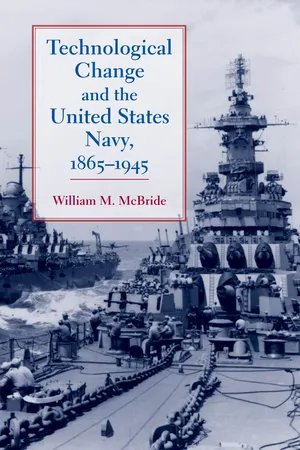
- English
- ePUB (mobile friendly)
- Available on iOS & Android
Technological Change and the United States Navy, 1865–1945
About this book
Winner, Engineer-Historian Award from the American Society of Mechanical Engineers
Navies have always been technologically sophisticated, from the ancient world's trireme galleys and the Age of Sail's ships-of-the-line to the dreadnoughts of World War I and today's nuclear-powered aircraft carriers and submarines. Yet each large technical innovation has met with resistance and even hostility from those officers who, adhering to a familiar warrior ethos, have grown used to a certain style of fighting. In Technological Change and the United States Navy, William M. McBride examines how the navy dealt with technological change—from the end of the Civil War through the "age of the battleship"—as technology became more complex and the nation assumed a global role. Although steam engines generally made their mark in the maritime world by 1865, for example, and proved useful to the Union riverine navy during the Civil War, a backlash within the service later developed against both steam engines and the engineers who ran them. Early in the twentieth century the large dreadnought battleship at first met similar resistance from some officers, including the famous Alfred Thayer Mahan, and their industrial and political allies. During the first half of the twentieth century the battleship exercised a dominant influence on those who developed the nation's strategies and operational plans—at the same time that advances in submarines and fixed-wing aircraft complicated the picture and undermined the battleship's superiority.
In any given period, argues McBride, some technologies initially threaten the navy's image of itself. Professional jealousies and insecurities, ignorance, and hidebound traditions arguably influenced the officer corps on matters of technology as much as concerns about national security, and McBride contends that this dynamic persists today. McBride also demonstrates the interplay between technological innovation and other influences on naval adaptability—international commitments, strategic concepts, government-industrial relations, and the constant influence of domestic politics. Challenging technological determinism, he uncovers the conflicting attitudes toward technology that guided naval policy between the end of the Civil War and the dawning of the nuclear age. The evolution and persistence of the "battleship navy, " he argues, offer direct insight into the dominance of the aircraft-carrier paradigm after 1945 and into the twenty-first century.
Frequently asked questions
- Essential is ideal for learners and professionals who enjoy exploring a wide range of subjects. Access the Essential Library with 800,000+ trusted titles and best-sellers across business, personal growth, and the humanities. Includes unlimited reading time and Standard Read Aloud voice.
- Complete: Perfect for advanced learners and researchers needing full, unrestricted access. Unlock 1.4M+ books across hundreds of subjects, including academic and specialized titles. The Complete Plan also includes advanced features like Premium Read Aloud and Research Assistant.
Please note we cannot support devices running on iOS 13 and Android 7 or earlier. Learn more about using the app.
Information
Table of contents
- Cover Page
- Title Page
- Copyright Page
- Dedication
- Contents
- Acknowledgments
- Introduction
- 1 The Postbellum Naval Profession: From Discord to Amalgamation
- 2 Competing for Control: Line Officers, Engineers, and the Technological Exemplar of the Battleship Paradigm
- 3 Refining the Technological Ideal: The Simsian Uproar, Engineer Bashing, and the All-Big-Gun Battleship
- 4 Technological Trajectory: Geostrategic Design Criteria, Turboelectric Propulsion, and Naval-Industrial Relations
- 5 Anomalous Technologies of the Great War: Airplanes, Submarines, and the Professional Status Quo
- 6 Controlling Aviation after the World War: The 1924 Special Board and the Technological Ceiling for Aviation
- 7 Disarmament, Depression, and Politics: Technological Momentum and the Unstable Dynamics of the Hoover-Roosevelt Years
- 8 War and a Shifting Technological Paradigm: Fast Task Forces and “Three-Plane” Warfare
- 9 Castles of Steel: Technological Change and the Modern Navy
- Notes
- Note on Sources
- Index